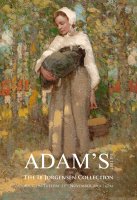

78
67
Colin Middleton RHA RUAMBE (1910-1983)
Girl with Sunflower
Oil on canvas, 60 x 45cm (23.6 x 17.7”)
Signed; also signed, inscribed, dated 1952 and numbered ‘140’ verso
‘Girl with a Sunflower’ would seem to be one of the most unambiguously optimis-
tic of Colin Middleton’s paintings from the period when he lived around Ardglass,
a time of great success and recognition when Middleton was exhibiting with Vic-
tor Waddington in Dublin and the Arthur Tooth Gallery in London.
The present painting is part of a powerful series of works from the early 1950s that
depicted a single female figure in a landscape, often with an object or accompa-
nying accessory that both amplifies and defines her nature and the mood of the
work. The darker themes of many of the paintings of this time, often affected by
the hardships and drama of the seafaring life of Ardglass, appear to be absent from
‘Girl with Sunflowers’. The female form is closely associated with the landscape,
both in the pattern of short brushstrokes that defines them and also tonally, and
her nakedness aligns her to more to nature than to our world. This connection is
stressed by the sunflower placed in her hair that seems to reach away from her and
towards the sun.
In this painting, the sunflower seems to suggest a harmony and fertility across
the natural world and perhaps reflects not only the artist’s joy in his professional
success but also his love of the landscape around Ardglass and above all his happy
domestic life; in the early 1950s Middleton and his wife had two young children
as well as the two girls from his wife’s first marriage and the sunflower’s association
with warmth, happiness and adoration hints at this.There is a very definite division
between the cultivated garden in which the girl sits and the sweeping landscape
beyond, perhaps aligning both her and the optimism of the work with the domes-
tic world of home and family.
It is also interesting to consider whether Middleton intended to pay homage to
van Gogh, one of the seminal early influences on his work, through choosing a
flower so associated with the great painter whose work he had first seen in London
in 1928.
Dickon Hall
€15,000 - 25,000



















